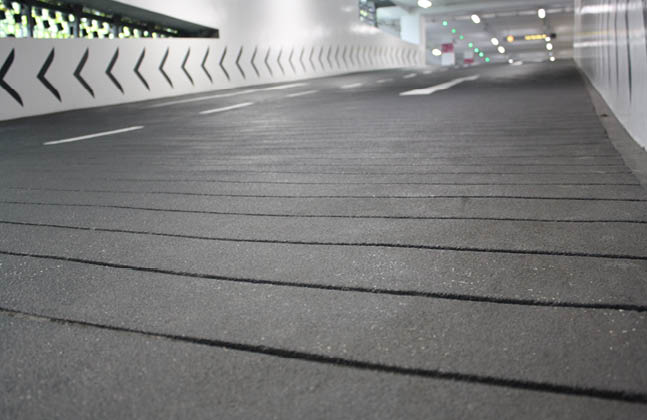Our previous posts on car park flooring have focused on a number of environmental and construction issues, but in this article we’ll look at a key functionality that all car park floors must provide – slip resistance.
This is important because not only does it make sure that vehicles can safely move around but the aggregates used to enhance slip resistance also strengthen the coating.
Let’s Ramp Things Up
There are a couple of areas where slip resistance is more problematic but also more critical, namely on the ramps and tight turning areas (check out points 4 and 5 on this 3D car park model).
You may not know this, but there are two main types of ramp within a car park. The first is a connecting ramp that vertically links separated parking decks and the second are parking ramps that combine the functions of circulations and storage in spiral or helical car parks. Both types can either be curved or straight, although this has a large impact on the gradient of the ramp and the forces required for a car to move along it.

Slip resistance is vital on a car park’s ramps. This example has both a textured finish and grooves to enhance traction.
The challenge in these places stems from the fact that a heavy vehicle making a tight turning motion puts a lot of pressure, mechanical impact, vibration and abrasion through the tyre’s small contact area and into the floor. Not only does the car need help with gripping in these circumstances, but the floor needs to be able to deal with this intense pressure and abrasion over and over again.
Slip resistance is also all the more crucial on exposed ramps or where there is the potential for rainwater to get into the site, as obviously it’s even harder for a car to grip onto a wet surface than a dry one.
Interestingly, ramps and turning circles are one of the most complex areas of the structure for engineers and architects, as they often need to push for shorter, narrower ramps with low floor to ceiling spaces in order to maximise parking capacity. Temperature changes can also affect the joints on the structure where the ramps connect to the different levels of a multi-storey building.

Tightly curving ramps like this are not only structural challenging but also difficult to drive around if the tyres can’t grip to the floor.
“Turning” Car Park Flooring to 11
To make sure that these areas are up to the task at hand, it should have a number of specific properties. For example, a higher thickness is required and it needs to have the right thixotropic profile (which is essentially the flowing consistency) to ensure that it won’t just run down the slope when being applied.
But the amount of traction and its ability to maintain a tough, supportive surface for the long term really comes from the choice of aggregate incorporated within the floor’s make-up. Many coatings will opt for sand, however in tough locations such as the ramps and turning circles, this will typically wear away much too quickly.
Standard sand just doesn’t have the abrasion resistance to withstand the wear that it will face, and once it’s been worn away vehicles will suddenly start struggling to cling to the floor and the facility risks cars slipping around in these problematic zones.
This is why specialist car park deck coating solutions, such as the Deckshield range, utilise aggregates made from aluminium oxide or bauxite instead of sand. These materials are much hardier and when broadcast into a thick, durable polyurethane system creates a strong, textured and reliable finish.

In this close up you can see the texture in a polyurethane deck coating created by using aluminium oxide aggregates.
These two materials are very similar (in fact, aluminium oxide is the more processed form of bauxite) and they can be found in a number of engineering and construction processes.
Aluminium oxide is among the hardiest compounds available, which is exemplified by the fact that it is often used as a component in cutting tools. In addition to this, it is also very lightweight, which is ideal for floor coatings as it reduces the weight being placed on the structure.
The versatility of polyurethane coatings means that the size and amount of aggregate broadcast into it can be easily adapted. Therefore, the same system can be specified for the whole floor and then the contractor can quickly and simply make the appropriate changes for those areas that need a courser, stronger build-up.
If you’d like more information to make sure that you don’t slip up on slip resistance, why not drop us a message or talk to the resin flooring experts.





